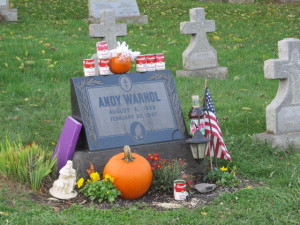October 20, 2014
Monday
In the future, everyone will be world-famous for fifteen minutes.
— attributed to Andy Warhol, 1928-1987, American artist
I started my new year of writing and reading and just plain being on August 31. The iron door of the north clanged open then and I endeavored to leave a flat and unproductive year behind and head into the new one with better focus and renewed determination. Just as I always did with the school year, I marked out a twelve-week Fall Term that would take me to the week of Thanksgiving: books to read, material to write, people to see, clutter to dispatch.
And, as often happened with the school year, I found myself at the mid-point of the term with the plans in some disarray. Time for a head-clearing Gallivant and the company of other writers. In the past I’ve gone to a silent retreat at the Jesuit facility where I am a frequent guest. This time, though, I chose Barrelhouse Magazine’s fall version of their high-energy Conversations and Connections program, scheduled for Pittsburgh, an easy three-hour drive west through some of Pennsylvania’s best fall scenery.
The drive is easy, but the Saturday conference starts at nine in the morning. So on Friday afternoon, I set out to pursue an intention I had forgotten about, but found in some notes while I was looking for something else: to visit Andy Warhol’s gravesite in Bethel Park, Pennsylvania, a little south and west of Pittsburgh.
I am, as readers of this space know, a big fan of cemeteries and gravesite visits. I am not really a fan of Andy Warhol, although I understand his importance in our cultural history. Other than his celebrity as one of the seminal figures in Pop Art and his quip about being famous, I don’t know much about him. What drew me to the idea of visiting his gravesite was the fact that there is a live webcam trained on it, broadcasting activities there 24 hours a day.
Warhol was only 58 when he died in 1987. He was private about his spirituality. Most people did not know that he attended Mass almost daily, most often at St. Vincent Ferrer Roman Catholic parish and St. Mary’s Byzantine Catholic parish, both in Manhattan. His funeral was held in Pittsburgh, his home town, at a Byzantine rite church. He was buried in St. John’s Byzantine Cemetery in Bethel Park, a suburb south of the city.
In 2013, the Andy Warhol Museum launched Figment, the webcam project. It takes its name from this thought:
I never understood why when you died, you didn’t just vanish, and everything could just keep going on the way it was only you just wouldn’t be there. I always thought I’d like my own tombstone to be blank. No epitaph and no name. Well, actually, I’d like it to say “figment.â€
The cemetery is on a hill above a busy street. Traffic was heavy along that route, and though getting through the city after I left the turnpike was a breeze, it took me forty minutes to navigate the last five miles to Connor Road. Once there, though, it was easy to find the Warhol site.
 I found it by first noticing the telephone pole with two cameras mounted on it. The Warhol plot is in the front row, up an embankment so steep I had to use my walking pole to climb up. At left is a picture I took when I arrived. I don’t know why the flag is there — Warhol was not a veteran. The soup cans, of course, are a reference to his 1962 painting, Campbell’s Soup Cans. I’ve seen the work at the Museum of Modern Art. The cans are collected and given to hunger relief agencies in the area, but it didn’t look like they’d been collected recently, so I was glad I hadn’t brought one. The purple object is a plastic accordion folder with sheets of paper inside. “Leave a note for Andy” is written in marker on the flap. I did.
I found it by first noticing the telephone pole with two cameras mounted on it. The Warhol plot is in the front row, up an embankment so steep I had to use my walking pole to climb up. At left is a picture I took when I arrived. I don’t know why the flag is there — Warhol was not a veteran. The soup cans, of course, are a reference to his 1962 painting, Campbell’s Soup Cans. I’ve seen the work at the Museum of Modern Art. The cans are collected and given to hunger relief agencies in the area, but it didn’t look like they’d been collected recently, so I was glad I hadn’t brought one. The purple object is a plastic accordion folder with sheets of paper inside. “Leave a note for Andy” is written in marker on the flap. I did.
Warhol’s parents are in a double plot with a single marker behind him. A plaque with his mother’s picture and the thought about the fifteen minutes is propped against it. The top of that stone is flat, and visitors have placed coins there, a popular tradition. I left a coin as well.
There was absolutely no one around. I called Ron. He brought up the webcam on his computer. I waved, called out hello (the webcam stream has audio as well as video). Ron was unable to get a screenshot. It did not occur to me until later that Ron might not have been the only person watching at that moment.
It had taken me longer than I thought to arrive at this first stop on the gallivant. The wind was picking up, and a few stray raindrops were hinting that a thunderstorm was building. I still had about forty minutes (if there was no traffic) to go to my hotel, and I wanted to attend the conference poetry reading at 7:00.
Before I left, I took a picture of the pole and the cameras trained on the gravesite. That seemed a very Marshall McLuhan-esque thing to do. I had been at the cemetery approximately fifteen minutes.
